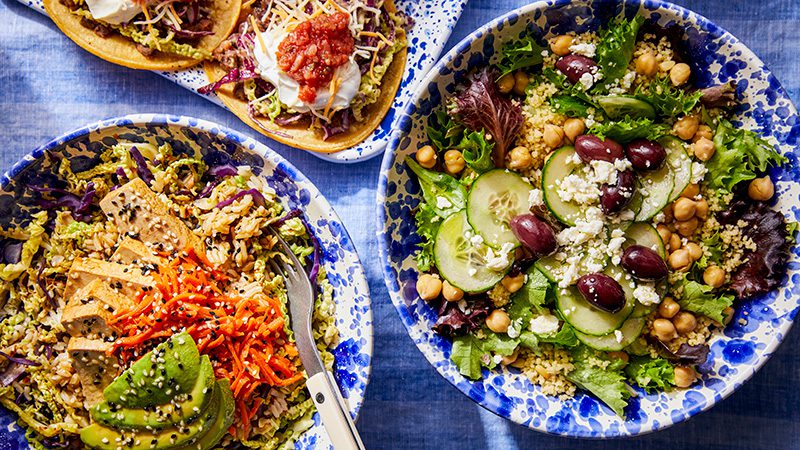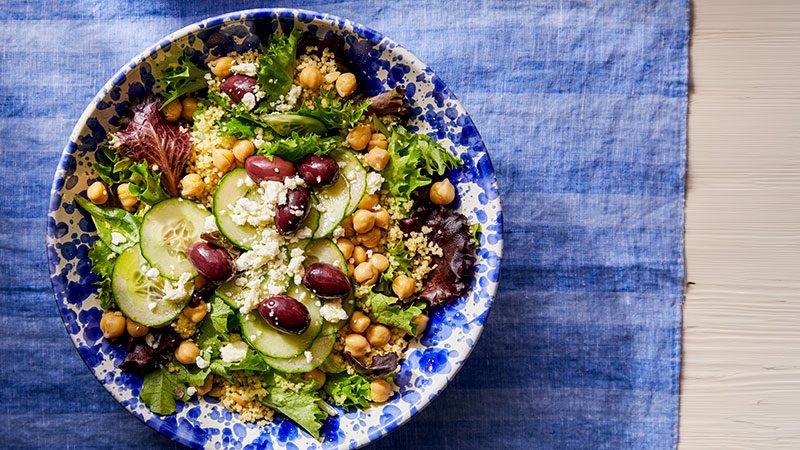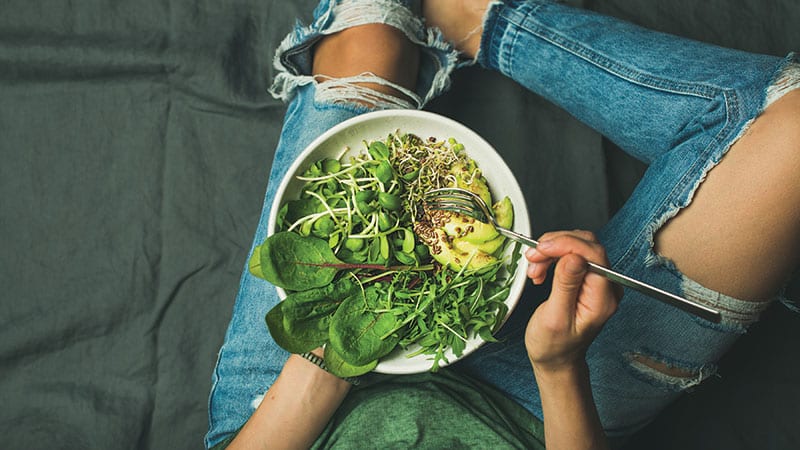Introducing the PBL (Plant-Based Lunch)
By Liz Wyosnick, guest contributor
This article was originally published in March 2024

Photo by Charity Burggraaf
The most simple and effective dietary advice for supporting health and longevity may be: eat more plants. Most Americans – 90%, by some estimates – miss that opportunity, falling short of federal nutrition guidelines that advise eating at least five servings of fruits and vegetables per day.
Plant-based foods rightfully deserve recognition for their health promoting benefits. They are uniquely devoid of excess sodium, excess sugar and an unfavorable fat profile. They’re also full of antioxidants, fiber and other beneficial bioactive compounds referred to as phyto-nutrients. Plants are the foundation of anti-inflammatory eating, and while colorful fruits and vegetables are a great way to gain their rewards, I also challenge individuals to look to heartier protein sources as a standout plant-based opportunity. Beans, lentils and soy-based proteins all have immense benefits, not to mention great flavors.
You don’t have to be vegan or vegetarian to reap the benefits of plant-based eating. Simply composing your meals to be predominantly plant-based, and taking a break from meat several times within your week, is hugely beneficial to your health. (Some think of this as a “flexitarian” diet.)
The midday meal poses a particularly great opportunity for including more plants in your eating patterns. While we often stick to the same routines for breakfast, and may need to satisfy a family or attend a social gathering for dinner, lunches create an individual opportunity to try potential new favorites while reducing the amount of meat or fish in your overall diet.
Need details? We’ve got plenty:
Benefits of plant-based lunches:
Better energy for the rest of your day:
Eating high-volume, nutrient packed food that is naturally low in fat and sodium will give you a revitalized, can-do feeling. That helps you recharge for the rest of your workday at a point when many people find their energy flags.
Increased daily fiber intake:
Fiber is only found in plant foods, and this special nutrient is beneficial for heart health, gut health and overall metabolic health. Elevated cholesterol? Irregular bathroom habits? Blood sugar challenges? Fiber is an important whole-body remedy. As you may surmise, since Americans fall short in their daily intake of fruits and vegetables, they also tend to fall short in reaching the daily recommended intake of fiber (25 grams per day for women, 35 grams per day for men). Beans, greens and whole grains are the top food sources of fiber and these foods can easily build a delicious lunch.
Anti-inflammatorY
Exciting research surrounding the gut microbiome is emerging, and yet we already know that a diverse community of bacteria seems to confer the best health benefit. This in turn is achieved through a diverse dietary pattern of fiber, or prebiotic foods. Research in this area indicates that an over-reliance on animal-based food can be inflammatory to the gut and the cardiovascular system. (Plus, aren’t we all looking for an alternative to the omnipresent chicken?
Increasing your protein vernacular to include beans of all varieties, lentils, soy, nuts and seeds will help diversify your gut microbiome and also expand your palate.
Supportive for weight loss/weight management.
In one randomized control trial in 2020, retested in 2022, participants were separated into two dietary groups. One group adopted a low-fat vegan diet and the other group made no changes to their typical omnivorous diet. In both studies, the vegan (100% plant-based) individuals lost more fat mass and improved insulin sensitivity just after 16 weeks. This weight loss effect may be due the high satiation effect of the high-volume, low-calorie food, as well as the increased energy participants’ bodies expended digesting plant-based, minimally processed food. While individual studies have their limits, a main consensus is that shifting diets from high consumption of animal-based foods (especially red and processed meat) to plant-based foods (e.g., nuts, legumes, and whole grains) can be associated with fat reduction and cardiometabolic benefit.
Better for the environment:
Of the greenhouse gas emissions that come from U.S. food and agriculture, animal foods tend to be the highest offenders. While different crops and farming practices have different effects, legumes add to the beneficial side because they are nitrogen-fixing. This means that the plants have the ability to use atmospheric nitrogen to play a crucial role in soil fertility and ecosystem health.
How to construct a plant-based lunch:
Ready to get started? My advice: Get going by taking your typical lunch and transforming it to a plant-based lunch.
For example:
Sandwich with lunchmeat → Open faced sandwich with roasted veggies, hummus and edamame
Lunchmeat wrap → black bean wrap (recipe below) Chicken salad → Mashed chickpea salad
Salad with grilled chicken → salad with quinoa and beans Chili → bean or lentil-based soup.
If you are not quite ready to try a fully vegetarian lunch, ease into it with a 50/50 mix. For instance, make a lunchtime salad bowl with 3 ounces of animal protein and ⅔ cup beans.

Nutritionist-approved plant-based lunch recipes
Check out these 3 PBL ideas featuring products found at PCC. Feel free to substitute comparable brand names if you can’t find these or have other preferences:
Greek Balance Bowl
1 serving, 15 minutes
Build your bowl from the bottom-up:
2 cups mixed salad greens
½ cup prepared Near East Pine Nut couscous
1 cup canned chickpeas, drained and rinsed
English cucumber slices, kalamata olives and a sprinkle of feta cheese
Dress bowl with a big swirl of olive oil
Warm Tofu Balance Bowl
1 serving, 15 minutes
Build your bowl from the bottom-up:
2 cups shredded cabbage, sauteed until softened
½ packet prepared Seeds of Change brown rice
½ packet of Wildwood baked, teriyaki marinated tofu, warmed and cubed
¼ cup Firefly yin-yang carrots
¼ avocado, sliced
Dress bowl with a couple swirls of olive oil and 1 swirl of low-sodium tamari and top with a sprinkle of sesame seeds.
Black Bean Tacos
3-4 servings, 15 minutes
Taco filling:
Mix 1 can of Amy’s Refried Black beans + 1 can black beans (rinsed and drained).
Cabbage slaw:
Mix 2 Tablespoons olive oil, the juice of 1 lime, the zest of 1 lime, ½ mashed avocado, and 2 teaspoons salt. Dress 4 cups of shredded cabbage with the olive oil, lime, and avocado mixture.
Additional toppings:
Greek yogurt, shredded cheese, salsa. Build your tacos within a tortilla of your choice.

Another short-cut to the PBL
Plant-based options from PCC’s deli provide another short-cut to the PBL. My suggestions (with recipes linked when available if you prefer making them from scratch):
- Perfect Protein Salad served over 2 cups of mixed greens
- Curried Tofu Cashew Salad over sautéed greens and brown rice
- Mediterranean Bean Salad served over 2 cups of mixed greens
- Sesame quinoa and Edamame served over 2 cups of mixed greens
- Steph’s Tofu over brown rice and sautéed greens
- PCC lentil soup
- PCC split pea soup
Registered Dietitian Nutritionist Liz Wyosnick serves as Dietitian in the Wellness Center at the Washington Athletic Club in downtown Seattle. She has a master’s degree in Nutrition Science.
